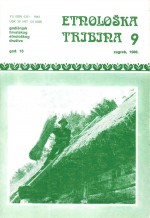Jurjevske kolednice v Beli Krajini
St. George's Day Kolednica in Bela Krajina
Author(s): Zmaga KumerSubject(s): Customs / Folklore, Music, Cultural Anthropology / Ethnology, Eastern Orthodoxy
Published by: Hrvatsko etnološko društvo
Keywords: Bela Krajina; kolednica; customs; religion; St. George's day;
Summary/Abstract: Kolednica is the name for the song by which participants in processions, koledniki, greet every house, getting presents in return. In Slovenia, this custom takes place on various holidays throughout the year. The ritual greeting koledovanje is part of more complex events at St. George’s Day (April 23/24) — the saint figure who has apparently taken place of some other spring deity o f ancient Slavs. In the past, kolednice songs must have been sung all over Slovenia because some were recorded in east Dolenjska, Rož in Carinthia and Bela Krajina even after World War II. While in Črnomelj adolescents performed St. George's ritual on the main square as a dramatic play (after the last war only as a show for tourists), in the villages of Bela Krajina school-children walked from house to house, sang kolednice and escorted a boy disguised in a bush of green: Zeleni Jurij (»Green Georgea). Until present, twenty-three St. George’s kolednice were recorded in Bela Krajina. Their text and melody differ from such songs in other Slovene regions. While the latter speak about St. George and have the form identical to kolednice sung at other holidays. St. George's kolednice from Bela Krajina start with verses on »Green George«; then follows a long account in rhymes of presents to be received — like in Croatian songs — and the expression of gratitude at the end is missing. The structure of the melody is of the children song type, with a third, and a second over it, in the base. This fact suggests that the oldest variants of kolednice were recorded at the time when St. George's ritual had already started to disintegrate and had become a children’s affair, before it finally disappeared after World War II.
Journal: Etnološka tribina : Godišnjak Hrvatskog etnološkog društva
- Issue Year: 16/1986
- Issue No: 9
- Page Range: 117-123
- Page Count: 7
- Language: Slovenian

